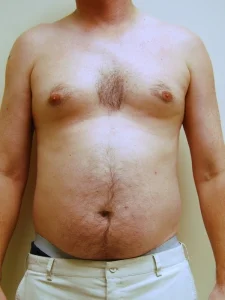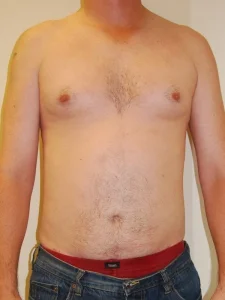Liposuction is a surgical procedure that recontours the body by removing unwanted fat deposits from targeted areas. A variety of techniques are available, including tumescent and ultrasound-assisted liposuction, which help patients achieve better results and shorter recovery times. Our board-certified plastic surgeon, Dr. Neil J. Zemmel, uses both of these techniques to recontour unwanted fat deposits throughout the body. Keep in mind that while liposuction can provide noticeable contouring results, the procedure is not intended for weight loss.
If you’re considering a body sculpting surgery like liposuction, please read the sections below to learn more about this cosmetic enhancement procedure. Dr. Zemmel will discuss your unique concerns and recommend an optimal treatment plan for you during your consultation.

What Areas Can Liposuction Treat?
The anatomic areas that can typically be treated with liposuction include:
- Abdominal wall
- Hips (“saddle bags”)
- Flanks (“love handles”)
- Buttocks (“banana roll”)
- Thighs
- Knees
- Lower legs
- Upper arms
- Cheeks (“jowls”)
- Neck (“double chin”)
What Does the Liposuction Consultation Entail?
During your initial consultation, Dr. Zemmel will evaluate your overall health and discuss with you at length the areas that concern you most. There are many physical details that make up the shape of your body which can be modified. Dr. Zemmel will evaluate:
- Your height and weight
- Your trunk to abdomen to pelvis proportions
- The shape and contour of your extremities
- The thickness of your skin
- The elasticity of your skin
- The muscle tone of your abdominal wall
- The shape of your umbilicus (belly-button)
- The areas of excess fatty tissue
Depending on his findings and your goals, Dr. Zemmel will explain the body contouring methods that will fit your unique needs. For patients that have excess skin exceeding the capabilities of liposuction, Dr. Zemmel may recommend an alternative procedure or combination of surgeries, such as an abdominoplasty (tummy tuck) to achieve optimal results. During the consultation, Dr. Zemmel encourages patients to ask questions and speak freely so he can build a treatment plan that is best for them to achieve the most optimal result.

What Can I Expect During My Liposuction Procedure?
The techniques involved in your liposuction procedure will depend upon your unique needs and the specifics of your surgical plan. Dr. Zemmel performs all liposuction procedures in accredited facilities with certified anesthesiologists to maximize patient safety. Smaller-volume liposuction is usually done on an outpatient basis. However, if a large volume of fat (greater than 4 liters) will be removed, or if liposuction is being performed in conjunction with other procedures, such as a tummy tuck or breast lift, an overnight stay in the hospital or a nursing facility may be required.
Step 1: Local or General Anesthesia
On the day of your liposuction procedure, you may be given sedation with local anesthesia. This is appropriate if only a small amount of fat and a limited number of body sites are involved. If your surgery is combined with additional procedures, a general anesthetic may be necessary.
Step 2: Tumescent Injections & Ultrasound Energy
Dr. Zemmel performs tumescent and ultrasound-assisted liposuction to help patients achieve optimal results from their procedure. These techniques help prepare the fat for removal via traditional liposuction methods. Dr. Zemmel will begin by performing the tumescent process, injecting a medicated fluid solution to the areas undergoing treatment. This fluid helps to maximize fat removal, reduce blood loss, and improve comfort during and after liposuction. After this solution takes effect, Dr. Zemmel will utilize low energy ultrasound to break up the fat, leaving the surrounding tissue intact.
Ultrasound-assisted liposuction targets the fat tissue only, leaving nerves, blood vessels, and skin in place. By breaking up only the fat, Dr. Zemmel is able to sculpt areas much more precisely. Treated areas tend to be smoother and blend in with the surrounding areas better than with traditional liposuction. The overlying loosened skin also tends to tighten to a greater extent than with traditional liposuction. This may eliminate the need for a skin removing procedure (tummy tuck, for example) in the future. Ultrasound-assisted liposuction has been shown to improve the ease and effectiveness of liposuction in fibrous areas of the body, such as the upper back and flanks or the enlarged male breast.
Step 3: The Fat Removal Process
Once the fat has been prepared via tumescent injections and ultrasound energy, small incisions (about 2mm to 4mm long) will be placed strategically around the treatment area. A narrow surgical tool known as a cannula is then inserted through these tiny incisions to suction out the excess fat cells. The cannulas are passed back and forth and the fatty tissue is removed. Each area is meticulously checked for symmetry and smoothness. Dr. Zemmel will take great care in making sure all areas blend in together.
As the fat is removed, fluid is also lost, so it’s crucial that this fluid be replaced during the procedure to prevent dehydration. For this reason, Dr. Zemmel and the anesthetist will carefully monitor you throughout and immediately after surgery.
“Dr. Neil Zemmel and staff have been absolutely wonderful from my first consultation, through the insurance process, Pre Op, Surgery, and Post Op.”
How Long Does Liposuction Take?
In general, liposuction takes about 1 to 3 hours, but this will vary based on the size of the target area, amount of fat removed, type of anesthesia, and technique being employed.
What Risks Are Associated with Liposuction?
Liposuction is considered a safe procedure when performed by a qualified surgeon. Dr. Zemmel has over 20 years of experience and selects patients very carefully to ensure they have a low risk of complications. You will undergo a thorough pre-operative evaluation to determine if you are healthy enough for the procedure. Dr. Zemmel cannot stress enough that safety is his primary concern.
Although complications from liposuction are rare, you will be informed of the possible risks ahead of time to help you know what to expect. The more areas being treated at once, and the larger these areas are, the higher your risk during surgery. Possible side effects from liposuction surgery include infection, poor healing, blood clots, excess loss of fluid, and skin or nerve damage. While these are rare, Dr. Zemmel takes every precaution to optimize your safety during your surgery. He will go over these risks with you beforehand, and if you have any questions or concerns, you are encouraged to voice them at any point during your liposuction journey.
How Long Is the Liposuction Recovery?
After your liposuction procedure, you may need to wear a compression garment for a few weeks to help facilitate the healing process. Dr. Zemmel will prescribe antibiotics, as well, to help prevent infection. Remember that healing is a gradual process. Dr. Zemmel will encourage you to begin walking right after surgery to reduce swelling and prevent the formation of blood clots. You should begin to feel better in a couple of days, at which point you can resume your normal daily activities. Most people return to work in 3 to 5 days or even sooner if they are up to it. The small stitches are removed in one week. Symptoms of bruising and swelling gradually fade within about two weeks but may take several months to completely heal.
Even though the newer liposuction techniques are believed to reduce some post-operative discomforts, you may still experience some pain, burning, swelling, bleeding and temporary numbness. Dr. Zemmel will prescribe pain control medications to increase your comfort during this time. You may still feel stiff and sore for a few days.
To aid in a safe recovery, it is best to hold off on more strenuous activities, such as running and lifting weights, for about four weeks. Dr. Zemmel will schedule regular follow-up visits to monitor your healing and recovery progress.

What Will My Liposuction Scars Look Like?
The incisions made for liposuction are typically very small. Dr. Zemmel will always make these incisions in the most inconspicuous areas to help naturally hide post-operative scarring. This involves placing the incisions under underwear lines and in natural creases. Over the course of the first year, these scars should gradually lighten, become softer, and flatten.
When Will I See My Liposuction Results?
You should begin to see your liposuction results soon after surgery, but more noticeable improvement is typically seen after 4 to 6 weeks, at which point most of the post-operative swelling will have faded. As residual swelling continues to fade, you should see your final liposuction results around 3 months. To prolong your new contouring results, Dr. Zemmel recommends following a healthy lifestyle by eating a nutritious diet and regularly exercising.
Additional Frequently Asked Questions About Liposuction
How much weight can you lose with liposuction?
For patients considering breast augmentation that are also experiencing sagging breasts (ptosis), a breast augmentation with lift, or augmentation mastopexy, may be recommended. The effects of drooping breasts may be categorized by different levels of the breast dropping below the crease underneath the breast (inframammary fold) and/or nipples that point downward. Additionally, a breast lift can remove excess, inelastic skin that may impact the results of a breast augmentation by itself. For the right candidates, a breast augmentation with lift can provide an overall more shapely, fuller, perkier, and youthful aesthetic outcome.
Is liposuction painful?
For the liposuction procedure, either sedation or anesthesia will be administered to ensure your comfort during surgery. Generally, post-operative pain or discomfort after liposuction tends to be minimal and can be well-managed with prescribed medication as directed. The advanced techniques used by Dr. Zemmel, including tumescent injections and ultrasound energy, help to maximize comfort by reducing blood loss and leaving nerves, tissues, and skin in place for a smoother, faster recovery.
Can fat grow back after liposuction?
The targeted fat cells removed during liposuction cannot grow back. Our bodies make a fixed number of fat cells so once they are eliminated they will not return. However, weight gain after a liposuction procedure may cause the remaining fat cells to fluctuate in size or move to other areas, which can lead to irregular body contours. Dr. Zemmel highly recommends maintaining a healthy weight and living an active lifestyle to prolong the results of liposuction.
Does liposuction tighten loose skin?
The aesthetic goal of a liposuction procedure is to remove targeted fat cells and further define the body’s shape, as opposed to addressing the concern of loose skin. After a liposuction procedure, each individual’s skin laxity and rate of healing will determine if their skin tightens naturally. It is worth noting that Dr. Zemmel utilizes ultrasound assisted liposuction to break up only the fat of the targeted areas, which may help to preserve the overlying skin in that region better than traditional liposuction. If more significant skin tightening is desired, Dr. Zemmel may recommend combining other procedures, such as a tummy tuck or other body contouring options, for an overall improved appearance.






